| 1 | Versus a polar bear |
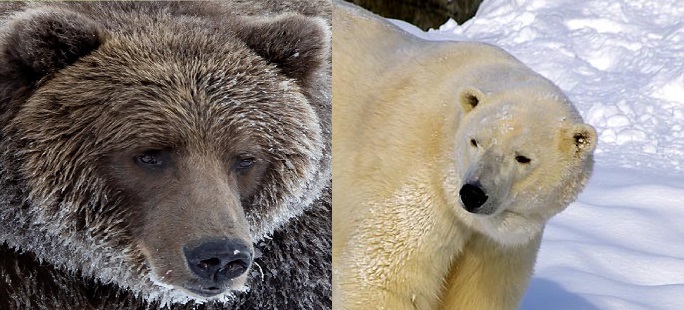
Few questions have been asked on the internet more. Who would win in a fight – the brown bear, or its close cousin the polar bear? The polar bear certainly has a size advantage, weighing 800-1200 pounds on average compared to the brown bear’s 400-800, and with a superior height of 9.5 feet versus 8 feet.
Hours, months or even decades have been poured into this debate via raging youtube comments, but most wildlife experts are agreed. When a polar bear and grizzly encounter each other in the wild, usually in Canada’s frozen far north, the smaller grizzly bear will win every time. In fact, the fight rarely comes to blows at all. The polar bear normally backs off at the mere sight of its evolutionary forefather, even when food is at stake.
The reason lies with the brown bear’s vastly superior muscular structure. The muscular hump on its back blesses it with immensely powerful forelimbs, with a swipe that produces devastating consequences from only average effort. The polar bear, on the other hand, is more slender, adapted to scooping out seals hiding beneath the icecap. They also hunt walruses, pouncing onto their backs, but face no other large land-dwelling predators.
Additionally, grizzly bears are naturally more aggressive, while polar bears tend to be cautious and reluctant. They have a strong bite designed to chew up vegetation, compared to the softer animal flesh which polar bears eat exclusively.
| 2 | Versus wolves |

Videos are plentiful of this confrontation, and it’s easy to sense the bear’s fear through the screen. The wolf pack typically encircles a bear and any cubs menacingly, with the worried bear timidly searching for an exit. But when push comes to shove, the odds are stacked heavily against the wolves. They have a decent chance, as their speed, agility and cooperation would confuse the bear sufficiently to allow a killer blow on the neck, but attacking the thick belly of blubber would be a massive waste of time.
If a single bear blow caught a wolf on its back, then its spinal column would shatter and recovery would be impossible. Wolves love to go for the legs, but a bear’s are like tree trunks. Brown bears have superb endurance. They can run at speeds of 25mph for 20 minutes without tiring, and this speed would pay dividends in the exhaustion of a fight.
Consequently, brown bears and wolves tend to tolerate each other’s presence. Surprisingly, a grizzly bear has only been observed killing a fully grown wolf once, although they do hunt down cubs for their dinner. The real competition comes in carcass rights, as according to Yellowstone Park manager Doug Smith, it isn’t a question of if a bear steals a wolf’s carcass, but when. However, like polar bears at a whale carcass, bears and wolves occasionally tolerate each other and never come to blows at all.
| 3 | Versus a tiger |
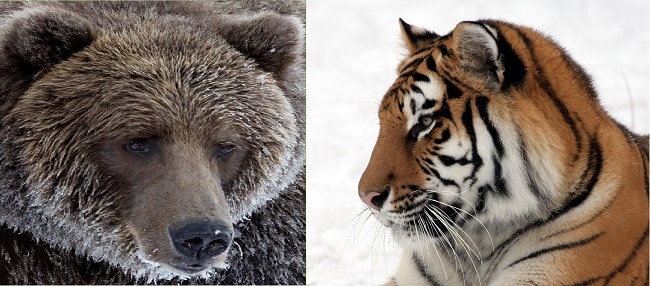
Except for a human wielding an AK-47, the tiger is the only mammal to coexist naturally with bears that has a decent chance of killing one. One expedition in the 1970s recorded 44 interactions between Siberian tigers and the Ussuri brown bear of north-east Asia. In 24 encounters, the animals avoided each other, but in the remaining 20, 50% resulted in a tiger victory, 27% in a bear victory, and 23% were a goalless draw.
The tiger has the advantage of being the initial silent stalker, whereas bears have never been observed to target tigers themselves. The tiger tends to position itself behind a rock or fallen tree, and wait for the unsuspecting Ussuri brown bear to pass. Suddenly, the tiger will leap from its hiding place, seize the bear’s head with its paws, and pierce its spinal column with a ruthlessly efficient bite to the neck.
At this point, the fight is all but over, but if the initial ambush fails, then the tiger is in serious trouble. With the element of surprise gone, any bites would land on the bear’s belly, an impenetrable armour of fat. Tigers are notorious for their poor endurance, and after several minutes, sluggishness would kick in, the tiger’s reactions slowed. The bear would then deliver a massive swipe of its paw, breaking several of the big cat’s bones. From that point on, it’s game over: the bear would deliver a clumsy, yet brutally strong clubbing which the weakened tiger has no chance of surviving.
| 4 | Versus a black bear |

Black bear/grizzly showdowns aren’t a common occurrence, as grizzly bears favour open land while black bears prefer the shelter of the forest. Similarly, a black bear can scavenge food all day, while brown bears prefer the dim hours of sunset and sunrise (except for its summer salmon bonanzas). But when a grizzly bear does approach from the distance, the black bear usually acts submissively and flees quickly. There’s a plentiful record of brown on black bear violence, particularly against the helpless cubs. In 1997, a grizzly bear was so determined to take out a nearby black bear that it went to the extreme of digging into its hibernation shelter.
In a straight fight between the two, there’s no contest. The brown bear’s muscular structure and density is vastly superior, aided by the all-conquering muscular hump on its back which the black bear totally lacks. The average grizzly bear weighs 400-800 pounds, while the American black bear hits the scales at 200-600 pounds.
The black bear does have one advantage: its nimbleness in climbing trees, aided by its rounded claws. But a brown bear has longer claws, specialised for digging, but equally useful for fighting. The species compete heavily for resources as well. The islands of British Columbia and Alaska tend to be bear paradises, but tellingly, they rarely have black and brown at the same time.
| 5 | Versus a cougar |
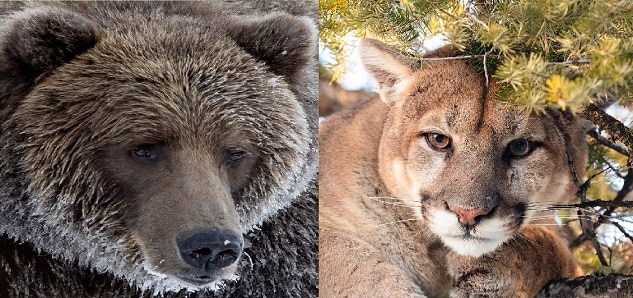
A cougar is a killing machine, a predator so efficient that its carcasses look like they could wake up and walk off again. However, a brown bear is just massive. Cougars have been known to kill cubs occasionally, but they wouldn’t dream of targeting a fully grown brown bear adult. Such an epic takedown has never been witnessed. Brown bears are equally disinterested in cougars, although rumour states that one brown bear was seen killing a cougar between 1993 and 1996.
The cougar faces similar problems to a tiger: their only hope would be an initial pounce onto the neck, followed by a severing of the spinal cord. This video of a disinterested bear and a fierce cougar mother defending her cubs shows exactly that, or an attempt at least. However, this requires a one in a million shot that would make it a legend among its fellow species members. Afterwards, the cougar would just be scraping its claws against a furry armour of blubber.
Bears, meanwhile, prefer to wait until a cougar takes down its prey, and chase the victor away from its rightful carcass. In a wildlife survey from 1995, this gained bears an average of 1.9kg of food per day. In Glacier National Park, brown bears frightened cougars away from 4 out of 8 carcass sites they ventured towards. In 2018, wildlife experts found that as brown bears recolonise lost wilderness areas of the US, the cougars in those areas tend to suffer.
| 6 | Versus a moose |

A common battle in the frigid Canadian north. The average moose is far too clumsy to fight off a brown bear, although they do sometimes charge in a valiant attempt. Bears have a fascinating tendency to hunt moose in icy scenarios. Their paws can scamper over anything, but moose hooves tend to struggle, giving bears a clear advantage. Sometimes, a bear will launch a clumsy swipe at a moose’s head and break its neck instantly.
In fact, this gave rise to one of the most enduring wildlife legends of all time: that a bear can decapitate a moose and send its head flying with a single swipe of its paw. This legend has long been the subject of meandering debates in pubs and bars. Some say that it’s ridiculous even by bear strength standards, but others warn against the perils of underestimating nature.
Tales abound of explorers sitting by rivers peacefully, only for a moose head to land next to their picnic basket. The truth? Statistics show that 15 documented cases of moose decapitation have happened since 1895, when a Russian miner trekking through the wilderness saw the first case. The American Dr Jacob MacDonaldson was a sceptic until 1954, when he noticed a bear roaring at a stubborn moose that refused to budge. The bear lumbered over to the 1000 pound moose, swung its paw, and several hours later, MacDonaldson was delivering the decapitated head for autopsy.
| 7 | Versus a wolverine |

Relative to its size, the wolverine is undoubtedly a superior fighter to the brown bear. Its body is extremely muscular, its temperament is vicious, and its claws are the animal equivalent of Freddy Krueger’s fingers. Despite weighing only 30-50 pounds, wolverines are commonly documented taking sheep, roe deer and caribou.
It’s a true case of size doesn’t matter. That said, if a wolverine was cocky enough to hunt a grizzly bear, it would get a short, sharp reality check the moment the beast actually wandered into sight. Grizzlies weigh over 15 times more than the average wolverine, and a wolverine hunting a brown bear has never been observed. In Denali National Park, they are reported to actively avoid grizzly territory.
Wolverines are even wary of the smaller black bear. In 2002, wildlife researchers had tagged a wolverine with a radio collar in Yellowstone National Park. Suddenly, their sensors started beeping, sending out a mortality signal that the wolverine hadn’t moved for several days.
Following the trail, they found the animal dead, next to an elk carcass which had been dragged through the snow. The wounds on its body revealed the tell-tale signs of a black bear mauling. The wolverine had evidently decided to steal the black bear’s kill, with fatal consequences.
A brown bear then? The wolverine had better have some tiger buddies to back him up. That said, a wolverine was once observed fending off a grizzly bear ten times its size while defending a carcass.
| 8 | Versus a bull |
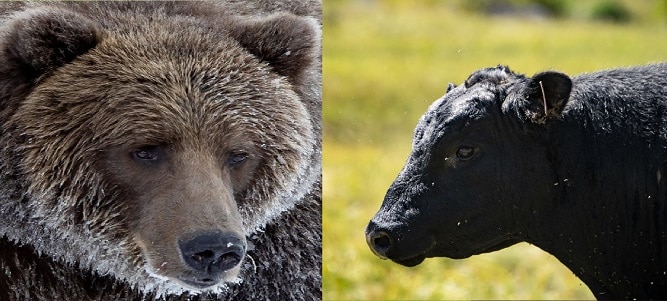
Nowadays, a brown bear and bull would never meet face to face in the wild. But in 19th century California, ordinary middle-class Americans carried on the traditions of their Roman forefathers by enjoying a lazy afternoon watching the two animals fight to the death. The fight “pits” were significantly less grand than a colosseum, a more temporary structure slapped together with logs and split-board fencing. The bear and bull would be tied together by a length of rope, to heighten their aggression as they attempted to pull apart in confusion.
The contest boiled down to sharp horns and fast charge versus brute strength. Who won the most competitions? The bear, of course. At first, the kidnapper cowboys feared that the bear would be defeated in mere minutes, causing them to saw the bull’s horns off. But the bear simply punched downwards and shattered the bull’s skull, and instead, the following fights were “raw”.
Still, the bear typically won. The bull would charge across the arena, only for the immensely powerful grizzly to seize its head in its paws. Then it would wrap its entire massive body around the bull, before raining down repeated killing blows. If the bear accidentally let go, then the bull would charge away in a panic, escaping the makeshift arena to freedom while being pursued by cowboys on horseback. The bull only won if its initial charge was well timed, and managed to gore the bear with a perfectly placed horn.
| 9 | Versus a horse |
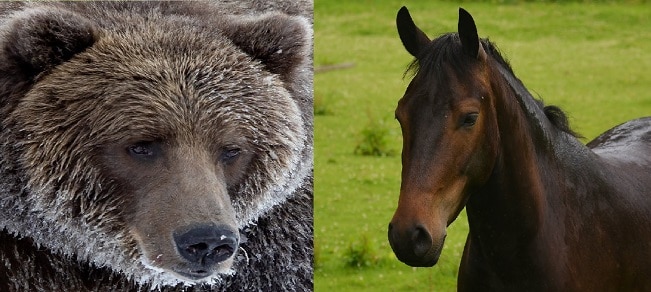
Horses aren’t generally known for their fighting prowess. They tend to be keener on running, which is why there’s no multimillion dollar bear racing industry. At 2000 pounds versus 800 pounds, a horse is significantly heavier than a brown bear, but horses are mostly restricted to kicking, and have rather fragile bones for such a large animal, bones which jump jockeys are always trying to fix with special diets.
However, defeat isn’t a done deal for the horse. Its hooves are the stuff of legends, extremely tough and consisting of compacted keratin proteins, the same proteins as a rhino’s horn. It has a kick span of 5 feet, and if a blow caught a bear on the head, it could easily cause catastrophic skull damage and end the battle right there. Survival is easy for a horse, as there’s always the option of running away, with a top speed of 40mph versus 35mph for the bear. The bear also has the problem of a horse’s sheer size, with layer after layer of tightly knotted muscle to slash through, a tall order no matter how sharp its claws are.
With the amount of ranches in Canada and the upper US states, this confrontation has been witnessed several times. A brown bear will never seek out conflict with a horse (proving that they have a peaceful heart), and if horses give chase, they normally flee from the property and return to the woods from whence they came.
| 10 | Versus a silverback gorilla |

It’s arguably the most pressing question facing humanity as we move through the 21st century. It’s a faceoff for the ages – who would win? A silverback gorilla stands at 4 to 6 metres tall and 300-400 pounds in weight, while a grizzly bear measures 8 feet tall and hits the scales at 600-800 pounds. The bear has a size advantage, but believe it or not, a silverback gorilla has a more powerful bite, measuring 1300 pounds per square inch, compared to the brown bear’s 1160 PSI (with a human scoring 126).
That said, as chest-beating and muscle bound as Hollywood would have us believe they are, the average gorilla isn’t King Kong himself. There’s no armour of blubber like a brown bear, and the bear’s razor sharp claws would rip into the flesh below almost instantly. A gorilla airlifted into the wilderness of Alaska would probably find itself flying through the air and landing in a river.
But the debate twists further with the gorilla’s superhuman strength. Gorillas are second only to certain insects (like ants) in disproportionate lifting feats, with superior fast twitch muscle fibres to bears. A silverback can carry two sedans over its head, and while bears are commonly spotted rolling mountain boulders out of their path, a gorilla is estimated to be 10-20 times stronger than a man, versus 7 times stronger for a bear. Gorillas are also highly intelligent. Who knows what tree swinging strategies they could come up with?
There’s no sign of this debate ending any time soon. There’s one other possibility of course: peace and cooperation…

Leave a Reply